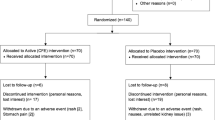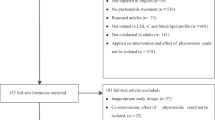Abstract
Objective: To determine whether the two major isoflavones in red clover differ in their effect on low-density lipoprotein cholesterol (LDL-C).
Design: A randomised, placebo-controlled, double-blind trial; two parallel groups taking one of the two isoflavones within which treatment and placebo were administered in a crossover design.
Setting: Free-living volunteers.
Subjects: A total of 46 middle-aged men and 34 postmenopausal women.
Interventions: Two mixtures of red clover isoflavones enriched in either biochanin (n=40) or formononetin (n=40) were compared. Placebo and active treatment (40 mg/day) were administered for 6 weeks each in a crossover design within the two parallel groups.
Main outcome measures: Plasma lipids were measured twice at the end of each period.
Results: Baseline LDL-C concentrations did not differ significantly between men (n=46) and women (n=34), nor between those randomised to biochanin or formononetin. Interaction between time and treatments, biochanin, formononetin and corresponding placebos (two-way ANOVA) on LDL-C showed a significant effect of biochanin treatment alone. The biochanin effect was confined to men; median LDL-C was 3.61 (3.05–4.14) mmol/l with biochanin and 3.99 (3.16–4.29) mmol/l with the corresponding placebo (RM ANOVA with Dunnett's adjustment P<0.05). The difference between placebo and biochanin effects on LDL-C was 9.5%. No other lipid was affected and women failed to respond significantly to treatment.
Conclusions: Isolated isoflavones from red clover enriched in biochanin (genistein precursor) but not in formononetin (daidzein precursor), lowered LDL-C in men. This may partly explain the previous failure to demonstrate cholesterol-lowering effects with mixed isoflavones studied predominantly in women.
Sponsorship: Novogen Ltd, North Ryde NSW, Australia, provided partial support including provision of tablets and outside monitoring.
This is a preview of subscription content, access via your institution
Access options
Subscribe to this journal
Receive 12 print issues and online access
$259.00 per year
only $21.58 per issue
Buy this article
- Purchase on Springer Link
- Instant access to full article PDF
Prices may be subject to local taxes which are calculated during checkout
Similar content being viewed by others
References
Anderson JW, Johnstone BM & Cook-Newell MB (1995): Meta-analysis of the effects of soy protein intake on serum lipids. N. Engl. J. Med. 333, 276–382.
Baum JA, Teng H, Erdman Jr JW, Weigel RM, Klein BP, Persky VW, Freels S, Surya P, Bakhit RM, Ramos E, Shay NF & Potter SM (1998): Long-term intake of soy protein improves blood lipid profiles and increases mononuclear cell low-density-lipoprotein receptor messenger RNA in hypercholesterolemic, postmenopausal women. Am. J. Clin. Nutr. 68, 545–551.
Busby MG, Jeffcoat AR, Bloedon LT, Koch MA, Black T, Dix KJ, Heizer WD, Thomas BF, Hill JM, Crowell JA & Zeisel SH (2002): Clinical characteristics and pharmacokinetics of purified soy isoflavones: single-dose administration to healthy men. Am. J. Clin. Nutr. 75, 126–136.
Clifton PM & Nestel PJ (1992): Influence of gender, body mass index, and age on response of plasma lipids to dietary fat plus cholesterol. Arterioscler. Thromb. 12, 955–962.
Cobb MA, Teitlebaum H, Risch N, Jekel J & Ostfeld A (1992): Influence of dietary fat, apolipoprotein E phenotype, and sex on plasma lipoprotein levels. Circulation 86, 849–857.
Crouse JR, Morgan T, Terry JG, Ellis J, Vitolins M & Burke GL (1999): A randomized trial comparing the effect of casein with that of soy protein containing various amounts of isoflavones on plasma concentrations of lipids and lipoproteins. Arch. Intern. Med. 159, 2070–2076.
Erdman Jr JW (2000): Soy protein and cardiovascular disease. A statement for healthcare professionals from the Nutrition Committee of the AHA. Circulation 102, 2555–2559.
Gardner CD, Newell KA, Cherin R & Haskell WL (2001): The effect of soy protein with or without isoflavones relative to milk protein on plasma lipids in hypercholesterolemic postmenopausal women. Am. J. Clin. Nutr. 73, 728–735.
Geil PB, Anderson JW & Gustafson NJ (1995): Women and men with hypercholesterolemia respond similarly to an American Heart Association step 1 diet. J. Am. Diet. Assoc. 95, 436–441.
Hodgson JM, Puddey IB, Beilin LJ, Mori TA & Croft KD (1998): Supplementation with isoflavonoid phytoestrogens does not alter serum lipid concentrations: a randomized controlled trial in humans. J. Nutr. 128, 728–732.
Howes JB, Sullivan D, Lai N, Nestel P, Pomeroy S, West L, Eden JA & Howes LG (2000): The effects of dietary supplementation with isoflavones from red clover on the lipoprotein profiles of post-menopausal women with mild to moderate hypercholesterolaemia. Atherosclerosis 152, 143–147.
Jenkins DA, Kendall CWC, Jackson C-J C, Connelly PW, Parker T, Faulkner D, Vidgen E, Cunnane SC, Leiter LA & Josse RG (2002): Effects of high- and low-isoflavone soyfoods on blood lipids, oxidized LDL, homocysteine, and blood pressure in hyperlipidemic men and women. Am. J. Clin. Nutr. 76, 4365–4372.
Lichtenstein AH, Jalbert SM, Adlercreutz H, Goldin BR, Rasmussen H, Schaefer EJ & Ausman LA (2002): Lipoprotein response to diets high in soy or animal protein with and without isoflavones in moderately hypercholesterolemic subjects. Arterioscler. Thromb. Vasc. Biol. 22, 1852–1858.
Lovati MR, Manzoni C, Canavesi A, Sirtori M, Vaccarino V, Marchi M, Gaddi A & Sirtori CR (1987): Soybean protein diet increases low density lipoprotein receptor activity in mononuclear cells from hypercholesterolemic patients. J. Clin. Invest. 80, 1498–1502.
Meinertz H, Nilausen K & Hilden J (2002): Alcohol-extracted, but not intact dietary soy protein lowers lipoprotein(a) markedly. Arterioscler. Thromb. Vasc. Biol. 22, 312–316.
Morito K, Hirose T, Kinjo J, Hirakawa T, Okawa M, Nohara T, Ogawa S, Inoue S, Muramatsu S & Masamune Y (2001): Interaction of phytoestrogens with estrogen receptors α and β. Biol. Pharm. Bull. 24, 351–356.
Nestel PJ, Pomeroy S, Kay S, Komesaroff P, Behrsing J, Cameron JD & West L (1999): Isoflavones from red clover improve systemic arterial compliance but not plasma lipids in menopausal women. J. Clin. Endocrinol. Metab. 84, 895–898.
Nestel PJ, Yamashita T, Sasahara T, Pomeroy S, Dart A, Komesaroff P, Owen A & Abbey M (1997): Soy isoflavones improve arterial compliance but not plasma lipids in menopausal women. Arterioscler. Thromb. Vasc. Biol. 17, 3392–3398.
Rowland IR, Wiseman H, Sanders TA, Adlercreutz H & Bowey EA (2000): Interindividual variation in metabolism of soy isoflavones and lignans: influence of habitual diet on equol production by the gut flora. J. Nutr. 36, 27–32.
Savolainen MJ, Rantala M, Kervinen K, Jarvi L, Suvanto K, Rantala T & Kesaniemi YA (1991): Magnitudes of dietary effects on plasma concentration: role of sex and apoprotein E phenotype. Atherosclerosis 86, 145–152.
Setchell KD (1998): Phytoestrogens: the biochemistry, physiology and implications for human health of soy isoflavones. Am. J. Clin. Nutr. 68(Suppl), 1333S–1346S.
Simons LA, von Konigsmark M, Simons J & Celermajer DS (2000): Phytoestrogens do not influence lipoprotein levels or endothelial function in healthy, postmenopausal women. Am. J. Cardiol. 85, 1297–1301.
Teede HJ, Dalais F, Kotsopoulos D, Liang YL & McGrath BP (2001): Soy protein dietary supplementation containing phytoestrogens improves lipid profiles and blood pressure: a double-blind, randomized, placebo-controlled study in men and post-menopausal women. J. Clin. Endocr. Metab. 86, 3053–3060.
Teixeira SR, Potter SM, Weigel R, Hannum S, Erdman Jr JW & Hasler CM (2000): Effects of feeding 4 levels of soy protein for 3 and 6 wk on blood lipids and apolipoproteins in moderately hypercholesterolemic men. Am. J. Clin. Nutr. 71, 1077–1084.
Tsunoda N, Pomeroy S & Nestel P (2002): Absorption in humans of isoflavones from soy and red clover is similar. J. Nutr. 132, 2199–2201.
Vigna GB, Pansini F & Bonaccorsi G (2000): Plasma lipoproteins in soy-treated postmenopausal women: a double-blind, placebo-controlled trial. Nutr. Metab. Cardiovasc. Dis. 10, 315–322.
Wangen KE, Duncan AM, Xu X & Kurzer MS (2001): Soy isoflavones improve plasma lipids in normocholesterolemic and mildly hypercholesterolemic postmenopausal women. Am. J. Clin. Nutr. 73, 225–231.
Acknowledgements
Novogen Ltd (North Ryde, NSW, Australia) provided the isoflavone supplements and placebo tablets and arranged an outside monitor to supervise the trial. All investigators contributed to the design and interpretation of the experiment.
Author information
Authors and Affiliations
Corresponding author
Rights and permissions
About this article
Cite this article
Nestel, P., Cehun, M., Chronopoulos, A. et al. A biochanin-enriched isoflavone from red clover lowers LDL cholesterol in men. Eur J Clin Nutr 58, 403–408 (2004). https://doi.org/10.1038/sj.ejcn.1601796
Received:
Revised:
Accepted:
Published:
Issue Date:
DOI: https://doi.org/10.1038/sj.ejcn.1601796
Keywords
This article is cited by
-
A Biocascade Approach Towards the Recovery of High-Value Natural Products from Biowaste: State-of-Art and Future Trends
Waste and Biomass Valorization (2021)
-
Red clover isoflavones enriched with formononetin lower serum LDL cholesterol—a randomized, double-blind, placebo-controlled study
European Journal of Clinical Nutrition (2015)
-
Intravenous pharmacokinetics and oral bioavailability of biochanin A in female rats
Medicinal Chemistry Research (2011)
-
In vitro production of radiolabeled red clover (Trifolium pratense) isoflavones
Plant Cell, Tissue and Organ Culture (PCTOC) (2009)



